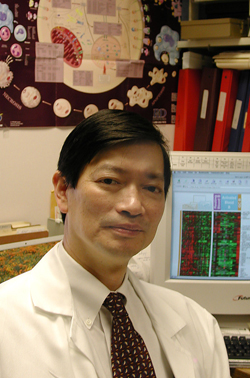 UNMC researcher Wing “John” Chan, M.D., answers questions about his work, life and interests.
UNMC researcher Wing “John” Chan, M.D., answers questions about his work, life and interests.
NOTE: This profile is part of a series highlighting the 25 researchers who were named UNMC Distinguished Scientists for 2006. Each of these researchers will be profiled in UNMC Today leading up to a March 12 ceremony to recognize their achievements.
- Name: Wing C. Chan, M.D.
- Title: Amelia and Austin Vickery Professor of Pathology, co-director of the UNMC Center for Lymphoma and Leukemia Research
- Joined UNMC: January 1991
- Hometown: Hong Kong
Describe your research in 25 words or less.
My current research involves the identification of genetic and gene expression abnormalities in non-Hodgkin’s lymphoma. The goal is to improve the diagnosis and prognostication of lymphoma and also to find new therapeutic targets for treatment.
How did you decide to pursue this area of research?
I have always been interested in hematological diseases. I did my residency in a department that was very strong in hematopathology and immunology and I had the chance to engage in research in these areas.
When did you realize you were interested in research?
I have always been interested in science, but I did not know what research involved until much later.
What are the greatest challenges in research today?
The greatest challenge in research today is to obtain funding and to attract the best and brightest to work with you.
Best advice for new researchers?
My advice for a new researcher is to select your area of research very carefully, to make sure that it has long-term potentials, and you will have mentors and collaborators that you can work with on that particular project. Then you should focus on that area and distinguish yourself in that field.
When an experiment stalls, what drives you to continue on?
I am a physician and a research project is like treating a patient for me. I try my best to overcome all difficulties and I do not give up easily. I suppose this is the attitude that keeps me going when I encounter difficulties. However, one also has to know when to let go. When you have exhausted all possibilities, you may have to find a new direction or even a new project.
Who has been your greatest teacher?
I do not have a single great teacher. My career has been influenced by a number of individuals including teachers at various stages of my education, friends and colleagues and I am grateful for their wisdom, support and advice.
Tell us about your family and hobbies outside the lab.
My wife and I are empty nesters now with both of my sons in college. I have to thank them for their support and understanding of the demand on my time due to my work and research activities. Outside of the lab, I like hiking, playing tennis and listening to music.
Globally, describe the most notable research achievement ever?
Since I work on molecular biology, especially on genetic abnormalities and gene expression in cancer, I think the discovery of the double helix by Watson and Crick is probably the most significant achievement in this area and set the stage for numerous subsequent discoveries.
Clarify a common misconception about research?
One common misconception about research is the image of a lone investigator making a discovery by himself or herself in a lab, in isolation. Currently, research is frequently a team effort, involving the collaboration or, at least the intellectual interaction of a number of investigators. Therefore, people skills are an important component of research.
What would you tell a student interested in a research career?
I would tell a student that a research career is a hard and challenging career. “Eureka moments” are far and few between and you need to enjoy the process of research, not just the discovery in order to survive in this career. You really need to have a passion for research, otherwise do not go into this career.
List something few people know about you.
I played the violin when I was young and I like to garden if I have time.